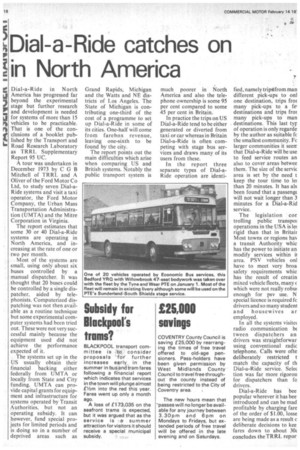Dial-a-Ride catches on in North America
Page 20

If you've noticed an error in this article please click here to report it so we can fix it.
Dial-a-Ride in North America has progressed far beyond the experimental stage but further research and development is needed for systems of more than 15 vehicles to be practicable. That is one of the conclusions of a booklet published by the Transport and Road Research Laboratory as TRRL Supplementary Report 95 UC.
A tour was undertaken in December 1973 by C G B Mitchell of TRRL and A Oliver of the Ford Motor Co Ltd, to study seven Dial-aRide systems and visit a taxi operator, the Ford Motor Company, the Urban Mass Transportation Administration (UMTA) and the Mitre Corporation in Virginia.
The report estimates that some 30 or 40 Dial-a-Ride systems are operating in North America, and increasing at the rate of one or two per month.
Most of the systems are small, using only about six buses controlled by a manual dispatcher. It was thought that 20 buses could be controlled by a single dispatcher, aided by telephonists. Computerized dispatching was not then available as a routine technique but some experimental computer systems had been tried out. These were not very successful mainly because the equipment used did not achieve the performance expected of it.
The systems set up in the US usually obtain their financial backing either federally from UMTA or locally from State and City funding. UMTA can provide capital grants for equipment and infrastructure for systems operated by Transit Authorities, but not an operating subsidy. It can however, fund special projects for limited periods and is doing so in a number of deprived areas such as Grand Rapids, Michigan and the Watts and NE districts of Los Angeles. The State of Michigan is contributing one-third of the cost of a programme to set up Dial-a-Ride in some of its cities. One-half will come from farebox revenue, leaving one-sixth to be found by the city.
The report points out the main difficulties which arise when comparing US and British systems. Notably the public transport system is much poorer in North America and also the telephone ownership is some 95 per cent compared to some 45 per cent in Britain.
In practice the trips on US Dial-a-Ride tend to be either generated or diverted from taxi or car whereas in Britain Dial-a-Ride is often competing with stage bus services and draws many of its users from these.
In the report three separate types of Dial-aRide operation are identi
lied, namely triptfrom man different pick-ups to onl one destination, trips frot many pick-ups to a fe, destinations and trips frot many pick-ups to man destinations. This last tyr of operation is only regarde by the author as suitable fc the smallest community. Fc larger communities it seenthat Dial-a-Ride will be use to feed service routes an also to cover areas betwee them. The size of the servic area is set by the need t keep the tour time to le than 20 minutes. It has als been found that a passengt will not wait longer than 3 minutes for a Dial-a-Rid service.
The legislation cor trolling public transpoi operations in the USA is le rigid than that in Britait Most towns or regions has a transit Authority whic has the power to initiate an modify services within it area. PSV vehicles on] have to meet very broa safety requirements whic has the result of creatin mixed vehicle fleets, many c which were not really robui enough for psv use. N special licence is required fc drivers and so many studeni and housewives ar employed.
In all the systems visite( radio communication Ix tween dispatchers an drivers was straightforwar using conventional radic telephone. Calls were ofte deliberately restricted t match the capacity of th Dial-a-Ride service. Selec tion was far more rigorou for dispatchers than fo drivers.
Dial-a-Ride has bee popular wherever it has bee introduced and can be mad profitable by charging fare of the order of $1.00, losse are being made as a result c deliberate decisions to kee fares down to about 30( concludes the TRRL repor




































































































